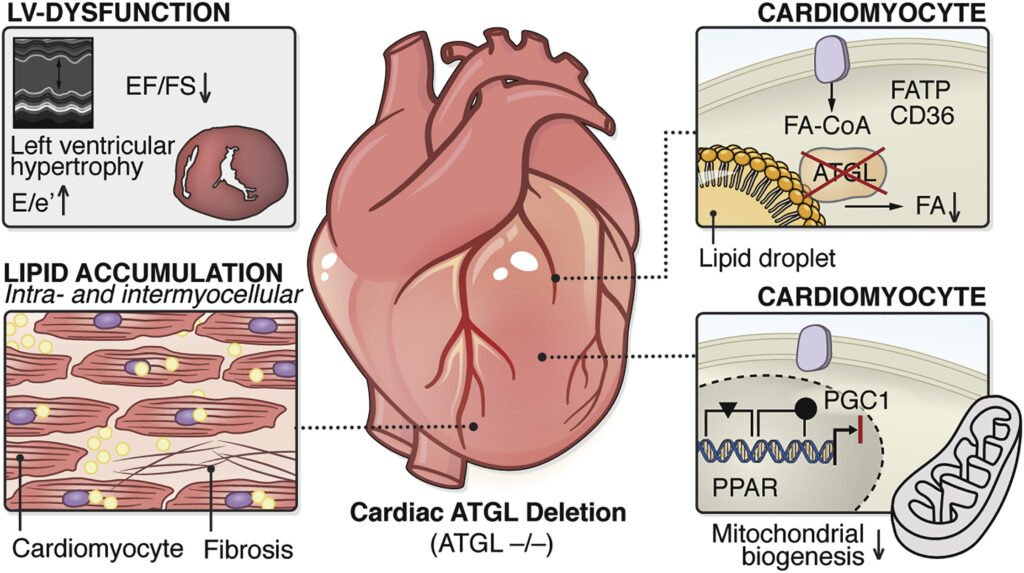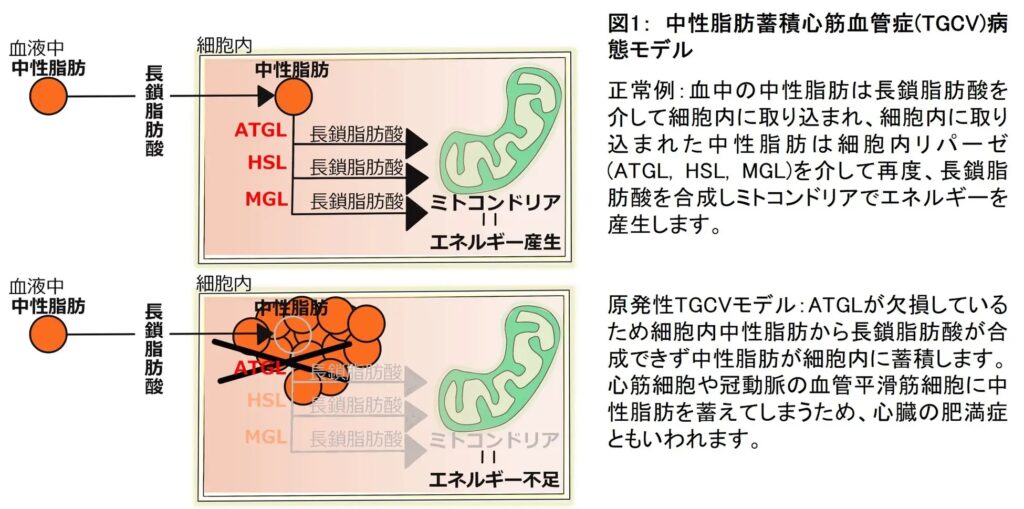生化学の教科書を読んだ自分の理解では、中性脂肪(トリアシルグリセリド)は脂肪細胞に蓄積されていて、必要に応じて脂肪細胞内で脂肪酸に分解されて、運びだされ、他の細胞の中に取り込まれて利用されると考えていました。
- 脂肪の代謝とその調節 ―からだのエネルギーバランス― 大学院生命理学研究科 教授 大隅 隆
しかし、心臓(心筋細胞)では、細胞内に運び込まれた脂肪酸は直接ミトコンドリアに運ばれてベータ酸化を受けるものもあれば、再び中性脂肪になって、細胞内で貯蔵もされるものもあるそうです。また、中性脂肪を代謝する酵素が働かない疾患では、心筋細胞などの内部に中性脂肪が異常に蓄積されてしまうこともあるそうです。
Excessive fatty acid (FA) uptake by cardiac myocytes is often associated with adverse changes in cardiac function. This is especially evident in diabetic individuals, where increased intramyocardial triacylglycerol (TG) resulting from the exposure to high levels of circulating FA has been proposed to be a major contributor to diabetic cardiomyopathy.
Cytoplasmic long-chain acyl-CoA esters that are not immediately diverted to acylcarnitines are incorporated into TG and phospholipids (159)
論文159:van der Vusse GJ, Glatz JF, Stam HC, Reneman RS. Fatty acidhomeostasis in the normoxic and ischemic heart. Physiol Rev72: 881–940, 1992
(Shedding light on the enigma of myocardial lipotoxicity: the involvement of known and putative regulators of fatty acid storage and mobilization 01 MAY 2010 https://journals.physiology.org/doi/full/10.1152/ajpendo.00509.2009 全文PDF)
別の論文から。
- Sharma and colleagues described high intramyocardial lipid content in LV tissue sections from patients with advanced non-ischemic HFrEF, with the highest content detected in patients with HFrEF and diabetes.
- myocardial TAG content correlated inversely with regional systolic function in healthy volunteers using 1H-magnetic resonance spectroscopy
- Two recent studies in HFpEF patients demonstrated significantly enhanced myocardial TAG accumulation compared to controls assessed by 1H-cardiac magnetic resonance spectroscopy
- in diabetic and obese mice, in which the cardiomyocyte-specific overexpression of ATGL reduced intramyocardial TAG levels, reduced lipotoxicity, and improved systolic and diastolic functional parameters, including EF, E/A ratio, or isovolumic relaxation time
- 引用元論文:The Role of Adipose Triglyceride Lipase and Cytosolic Lipolysis in Cardiac Function and Heart Failure
中性脂肪蓄積心筋血管症(Triglyceride deposit cardiomyovasculopathy, TGCV)に関する厚生労働科学研究費補助金 難治性疾患政策研究事業 中性脂肪蓄積心筋血管症研究班のウェブサイトにもわかりやすい図がありました。TGCVでは、心筋細胞、血管平滑筋細胞、内皮細胞、骨格筋細胞、多形核白血球、腎尿細管上皮細胞、膵島細胞等に中性脂肪 (TG) が蓄積するそうです。TGCV336例のうち10例では細胞内TG分解の必須酵素adipose triglyceride lipase (ATGL) をコードするPNPLA2遺伝子のホモ型変異が確認されているそうです。
別の論文の図も紹介。
- Within the cardiomyocytes the FAs are esterified to CoA and either stored in the lipid droplet (LD) or used for energy.
- At least four lipid-droplet proteins (perilipins; PLINs) are expressed in the heart.
- The lipid droplet supplies some oxidized FAs via the actions of adipose triglyceride lipase (ATGL)/desnutrin and hormone-sensitive lipase (HSL). CGI58 is the ATGL coactivator.
- 引用元論文:Lipid Metabolism and Toxicity in the Heart
日本の研究成果のプレスリリースから。
中性脂肪蓄積心筋血管症(TGCV)は、脂肪酸代謝異常で増加した中性脂肪が心筋や冠動脈に蓄積することで、心不全を引き起こす原因の一つではないかと考えられるようになってきました(図1) 。
(引用元:https://prtimes.jp/main/html/rd/p/000000387.000021495.html)
関連記事
- 肥満心筋症 名前上は肥大型心筋症と紛らわしい 高度肥満があることが大前提 心筋細胞の内側にも外側にも中性脂肪が蓄積し、それらがいわゆる脂肪毒性を発揮して心筋の収縮力を落としたり、結果的にはリモデリングを起こして線維化をきたして心筋の収縮力が悪くなる おそらく脂肪酸の利用障害がこの病態にかかわっているのではないか


